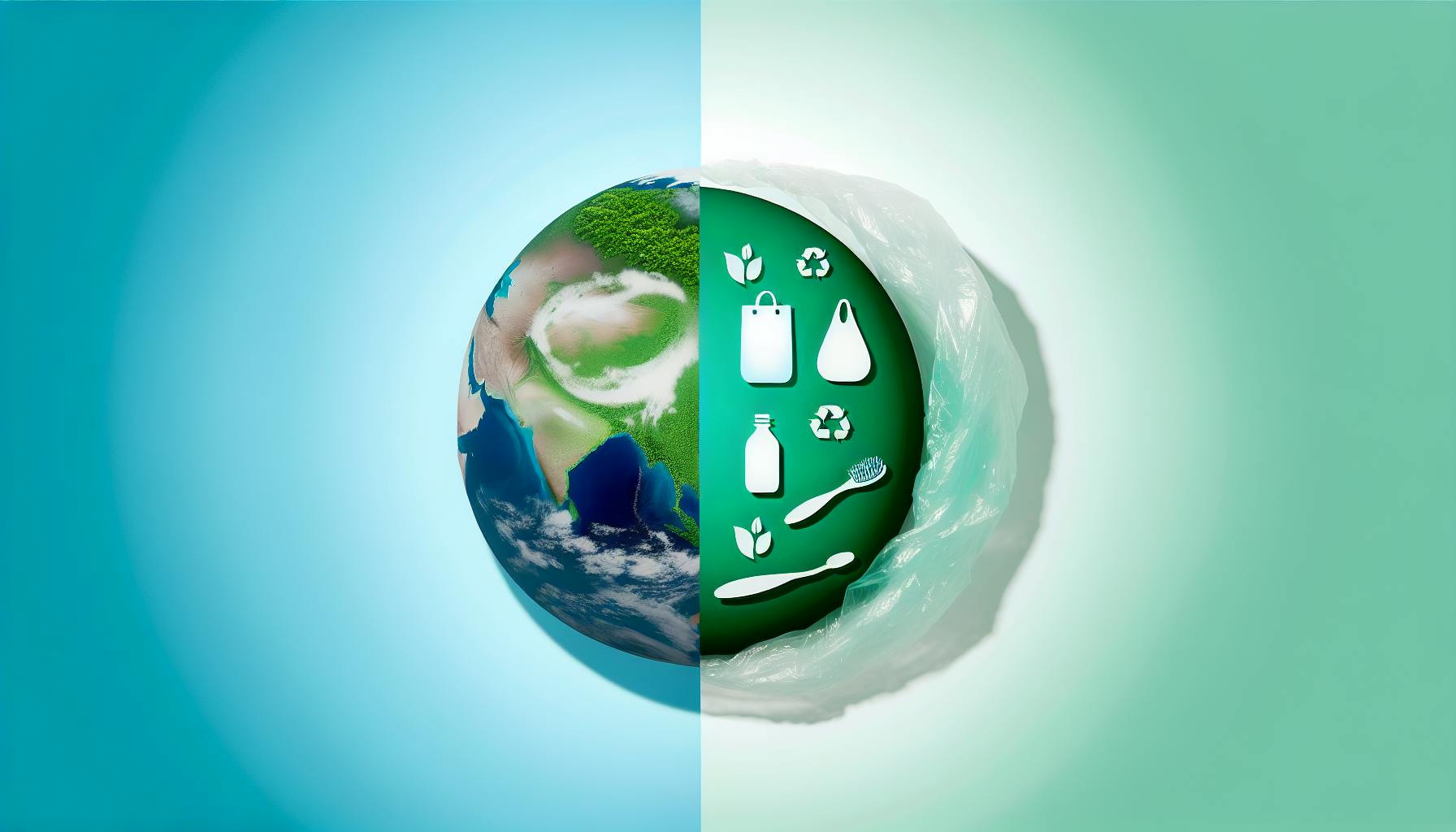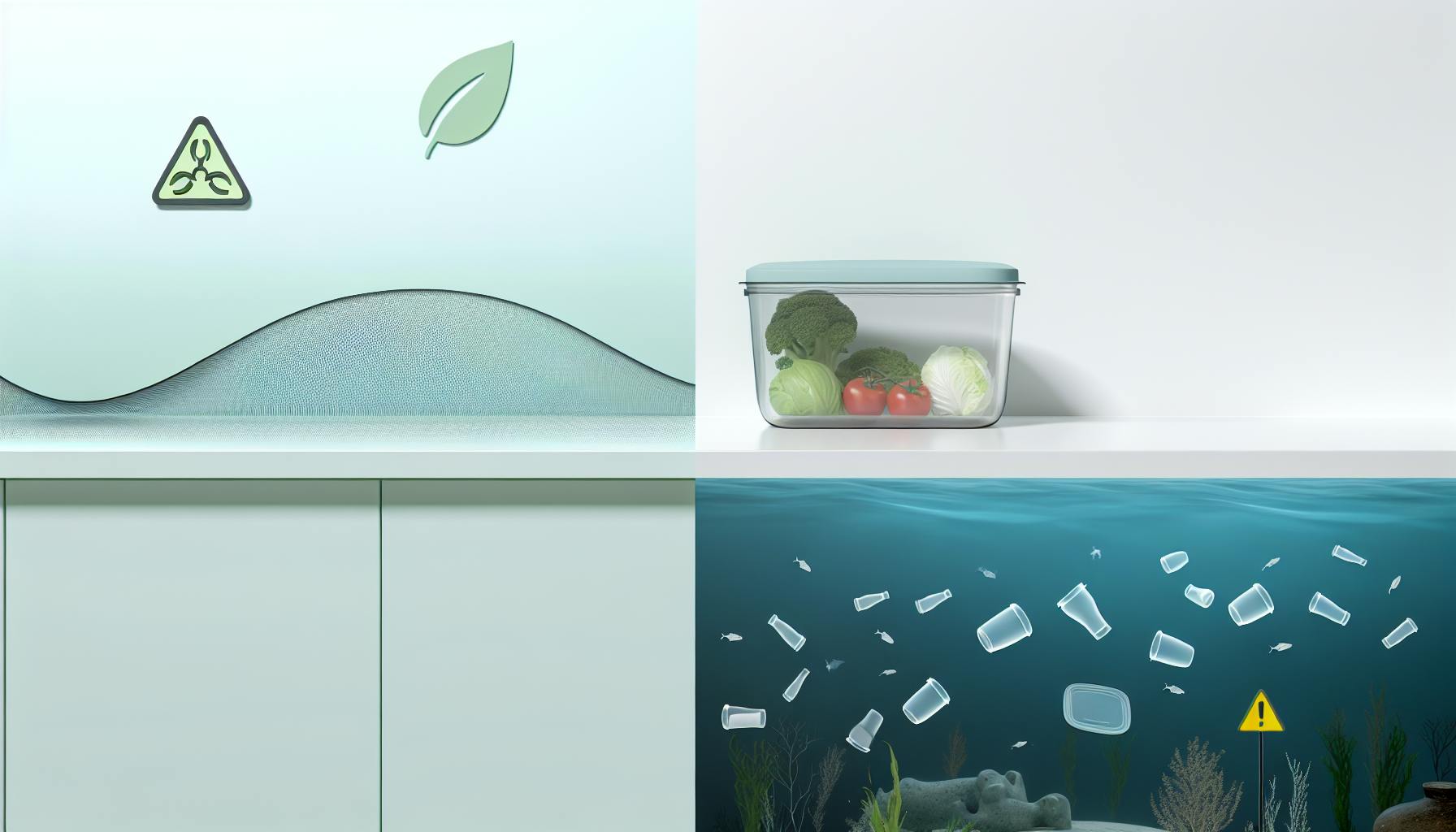Microplastics are tiny plastic particles less than 5 millimeters in size that can enter our food and drinks through various sources in the kitchen. To reduce exposure to these harmful particles:
Related video from YouTube
Replace Plastic Items
- Cookware & Utensils: Switch to glass, ceramic, stainless steel, wood, or bamboo
- Food Storage: Use glass containers, stainless steel, or beeswax wraps
- Drinking Containers: Choose glass, stainless steel, or silicone
- Cleaning Supplies: Use natural fiber sponges, microfiber cloths, and bar soaps
Reduce Plastic Waste
- Shopping: Bring reusable bags, buy in bulk, and rinse produce
- Laundry: Wash less often, use cold water, and microfiber-catching filters
- Cleaning: Vacuum with HEPA filters and clean kitchen items regularly
Plastic-Free Cooking
| Instead of | Use |
|---|---|
| Plastic water filter | Plastic-free filter |
| Plastic kettle | Glass or stainless steel |
| Tea bags | Loose tea |
| Plastic coffee pods | Stainless steel pods |
| Plastic wrap | Beeswax wraps |
| Plastic containers | Sustainable containers |
| Plastic utensils | Wood, bamboo, or metal |
| Plastic sponges | Hemp sponges |
By making conscious choices about the products you use and habits you adopt, you can significantly reduce microplastic pollution in your kitchen and contribute to a more eco-friendly lifestyle.
Microplastic Sources in the Kitchen
Microplastics can sneak into our food and drinks through various sources in the kitchen. Here's what you need to know:
Plastic Containers and Utensils
- Plastic containers, cutting boards, mixing bowls, blenders, kettles, and non-stick pans can release microplastics into food when heated or worn down.
- Solution: Switch to metal, glass, or wooden alternatives.
Synthetic Clothing Fibers
| Synthetic Fabrics | Impact |
|---|---|
| Polyester | When washed, these fabrics release tiny fibers (microfibers) that can end up in the kitchen through wastewater. |
| Nylon |
- Solution: Wash synthetic fabrics in a mesh bag or use a washing machine filter to capture microfibers.
Plastic Packaging
Plastic wrap, bags, and containers can break down into microplastics if not disposed of properly. These microplastics can then contaminate food and water in the kitchen.
2. Solution
Use reusable containers and bags to reduce plastic waste and microplastic generation.
Personal Care Products
1. Microbeads
Some personal care products like exfoliating scrubs and toothpaste contain tiny plastic beads (microbeads). These can enter the kitchen through wastewater and contaminate food and drinks.
2. Solution
Choose microbead-free personal care products.
Replacing Plastic Kitchen Items
Switching out plastic kitchen items is key to reducing microplastic contamination in your food and drinks. Here are some practical steps to make the switch:
Cookware and Utensils
Replace plastic cookware and utensils with:
| Material | Examples |
|---|---|
| Glass | Pyrex containers |
| Ceramic | Xtrema cookware |
| Stainless Steel | 360 Cookware pots and pans |
| Wood or Bamboo | Spoons, spatulas |
These materials are safe, long-lasting, and easy to clean. Avoid non-stick coatings, as they can release chemicals into your food.
Food Storage Containers
Instead of plastic containers, use:
- Glass containers with lids (e.g., Mason jars)
- Stainless steel containers (e.g., Lunch Prep Containers)
- Beeswax wraps or silicone lids for covering bowls
These reusable options are non-toxic and easy to clean and store.
Drinking Containers
Replace plastic water bottles and cups with:
| Material | Examples |
|---|---|
| Glass | Pyrex bottles |
| Stainless Steel | Hydro Cell bottles |
| Silicone | Stasher cups |
These durable, non-toxic options keep drinks hot or cold for hours.
Cleaning Supplies
Swap plastic cleaning supplies for:
- Natural fiber sponges and brushes
- Bar soap or powder detergents in cardboard or metal packaging
- Microfiber cloths for cleaning surfaces
These eco-friendly alternatives are effective and reusable.
Personal Care Products
Choose personal care products free from microplastics and synthetic ingredients:
- Natural soaps and shampoos in bar form or refillable containers
- Cosmetics with natural ingredients and minimal packaging
- DIY personal care products using natural ingredients like coconut oil and essential oils
sbb-itb-1dc3f59
Reducing Plastic Waste
Cutting down on plastic waste is key to lowering microplastic pollution in your kitchen. Here are some simple tips to help you reduce plastic waste daily:
Shopping and Food Prep
- Bring reusable bags and containers when grocery shopping to avoid plastic packaging.
- Buy in bulk or from local farmers to minimize plastic waste.
- Thoroughly rinse produce to remove any microplastics.
Laundry and Clothing
| Action | Benefit |
|---|---|
| Wash clothes less often | Reduces microfiber shedding |
| Use cold water | Prevents microfiber release |
| Use a microfiber-catching filter or ball | Captures microplastics from laundry |
| Air-dry clothes | Avoids microfiber release from dryers |
Cleaning and Maintenance
1. Vacuum and dust regularly
Remove microplastics from surfaces using a vacuum with a HEPA filter.
2. Clean kitchen items often
Prevent microplastic buildup by regularly cleaning utensils and appliances.
Conclusion
By taking simple steps, you can greatly reduce microplastics in your kitchen. Every small change makes a difference, and being mindful of the products you use and habits you adopt can positively impact the environment.
Start by replacing plastic kitchen items with eco-friendly options like:
| Material | Examples |
|---|---|
| Glass | Pyrex containers, bottles |
| Stainless Steel | Cookware, bottles, containers |
| Wood or Bamboo | Utensils, cutting boards |
| Ceramic | Cookware |
Be aware of microplastic sources like synthetic clothing fibers, plastic packaging, and certain personal care products with microbeads.
Adopt sustainable habits:
- Buy in bulk or from local sources to minimize plastic packaging
- Use reusable bags and containers when shopping
- Thoroughly rinse produce
Reduce plastic waste by:
- Vacuuming and dusting regularly to remove microplastics
- Cleaning kitchen items often to prevent buildup
- Using a microfiber-catching filter or ball in the laundry
- Air-drying clothes instead of using a dryer
Every small action counts. By making conscious choices about the products you use and habits you adopt, you'll reduce microplastic pollution in your kitchen and contribute to a more eco-friendly lifestyle.
FAQs
How can I avoid using plastic in my kitchen?
- Use reusable bags and containers when shopping
- Avoid plastic wrap, bags, and disposable containers
2. Replace plastic kitchen items
| Instead of Plastic | Use These Materials |
|---|---|
| Containers, bottles | Glass, stainless steel |
| Cookware, utensils | Ceramic, wood, bamboo |
| Cleaning supplies | Natural fiber sponges, microfiber cloths |
- Buy in bulk to minimize packaging
- Choose products with minimal or no plastic packaging
- Rinse produce thoroughly to remove any microplastics
4. Reduce plastic waste
- Vacuum and dust regularly with a HEPA filter
- Clean kitchen items often to prevent microplastic buildup
- Use a microfiber-catching filter or ball in the laundry
- Air-dry clothes instead of using a dryer
How do I cook without using plastic?
To cook without plastic, make these simple changes:
- Use a plastic-free water filter
- Choose a glass or stainless steel kettle
- Buy loose tea instead of tea bags
- Switch to a stainless steel coffee pod
- Use beeswax wraps instead of plastic wrap
- Opt for sustainable food storage containers
- Choose high-quality cooking utensils made from wood, bamboo, or metal
- Use a hemp kitchen sponge for cleaning


